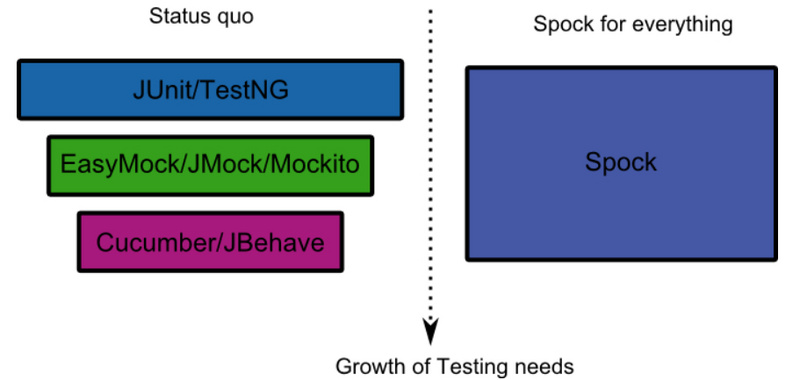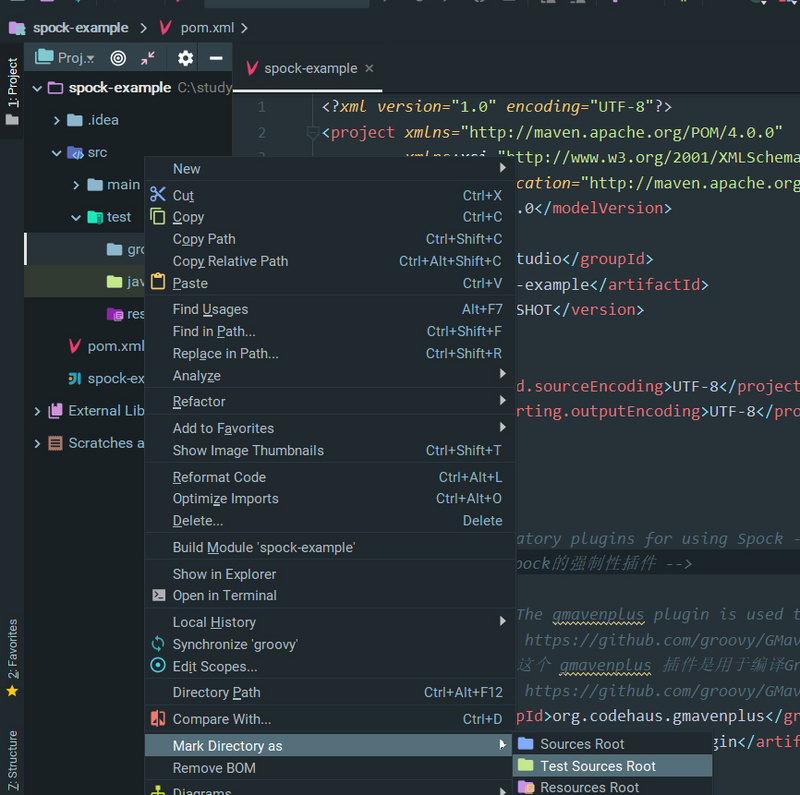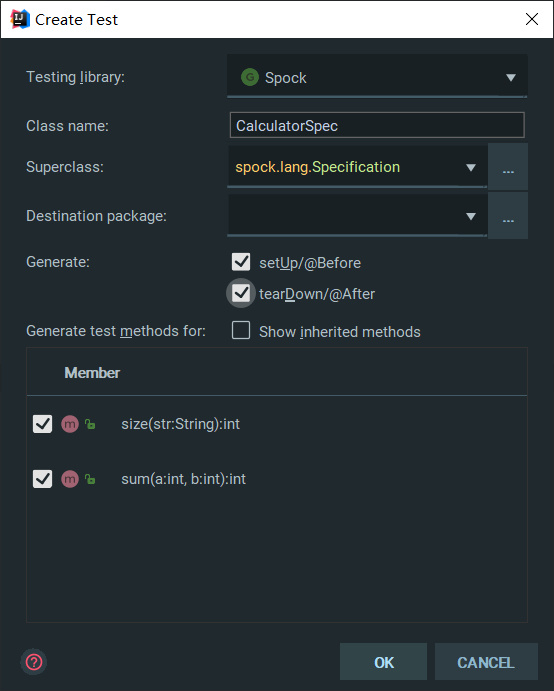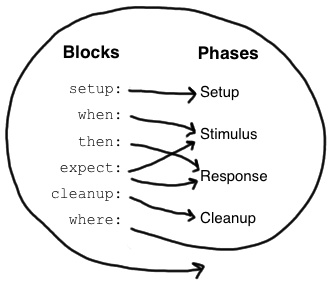Spock in Java 慢慢爱上写单元测试
Spock in Java 慢慢爱上写单元测试

前言
最近小组里面引进了Spock这个测试框架,本人在实际使用了之后,体验非常不错,同时在整个学习过程当中,学习了单元测试的相关知识。
本篇文章一是为了巩固输入的知识,二是为了向大家推广一下。
在了解学习Spock测试框架之前,我们应该先关注单元测试本身,了解我们常见的单测痛点,这样才能更好地去了解Spock这个测试框架是什么,我们为什么要使用它,能解决我们什么痛点。
现在让我们开始吧。
关于单元测试
我们写代码免不了要测试,测试有很多种,对于Javaer们来说,最初级的测试是写个main函数运行一个函数结果,或者说把系统启起来自己模拟一下请求,看输入输出是否符合预期,更高级地,会用各种测试套件,测试系统。每个测试都有它的关注点,比如测试功能是否正确,系统性能瓶颈等等。
那我们常说的单元测试呢?
中,一个单元就是单个程序、函数、过程等;对于面向对象编程,最小单元就是方法,包括基类(超类)、抽象类、或者派生类(子类)中的方法。
-- 摘自维基百科
以上是维基百科的说明。
单元测试当然不是必须之物,没了单测你的程序经过QA团队的端到端测试和集成测试之后,也能保证正确性。但是从另外的角度来看,单元测试也是必须之物。比如持续部署的前提之一就是有单元测试的保障,还有在重构代码的时候,没有单元测试你会寸步难行。
1.1 单元测试的好处
单元测试的好处包括但不限于:
- 提升软件质量
优质的单元测试可以保障开发质量和程序的鲁棒性。 越早发现的缺陷,其修复的成本越低。
-
促进代码优化
单元测试的编写者和维护者都是开发工程师,在这个过程当中开发人员会不断去审视自己的代码,从而(潜意识)去优化自己的代码。
-
提升研发效率
编写单元测试,表面上是占用了项目研发时间,但是在后续的联调、集成、回归测试阶段,单测覆盖率高的代码缺陷少、问题已修复,有助于提升整体的研发效率。
-
增加重构自信
代码的重构一般会涉及较为底层的改动,比如修改底层的数据结构等,上层服务经常会受到影响;在有单元测试的保障下,我们对重构出来的代码会多一份底气。
1.2 单元测试的基本原则
宏观上,单元测试要符合 AIR 原则:
- A: Automatic(自动化)
- I: Independent(独立性)
- R: Repeatable(可重复)
微观上,单元测试代码层面要符合 BCDE 原则:
- B: Border,边界性测试,包括循环边界、特殊取值、特殊时间点、数据顺序等
- C: Correct,正确的输入,并且得到预期的结果 **
- D: Design,与设计文档相符合,来编写单元测试
- E: Error,单元测试的目的是为了证明程序有错,而不是证明程序无错。 为了发现代码中潜藏的错误,我们需要在编写测试用例时有一些强制的错误输入(如非法数据、异常流程、非业务允许输入等)来得到预期的错误结果。
1.3 单元测试的常见场景
- 开发前写单元测试,通过测试描述需求,由测试驱动开发。(如果不熟悉TDD的同学可以去google一下)
- 在开发过程中及时得到反馈,提前发现问题。
- 应用于自动化构建或持续集成流程,对每次代码修改做回归测试。(CI/CD 质量保障)
- 作为重构的基础,验证重构是否可靠。
1.4 单元测试的常见痛点
下列痛点是我在日常开发中遇到的,
- 测试上下文依赖外部服务(如数据库服务)
- 测试上下文存在代码依赖(如框架等)
- 单元测试难以维护和理解(语义不清)
- 对于多场景不同输入输出的函数,单元测试代码量会很多
- ...
我对上面几点稍微做下解释。
首先,测试代码的代码量绝对不会比业务代码少(假设有覆盖率指标,且不作弊),有时候一个函数,输入和输出会有多种情况,想要完全覆盖,代码量只会更多。较多的代码量,加上单测代码并不想业务代码那样直观(靠写注释的方式,看的乱,写的累),还有一部分编码人员对代码可读性不重视,最终就会导致单元测试的代码难以阅读,更难以维护。同时,大部分单元测试的框架都对代码有很强的侵入性,要想理解单元测试,首先得学习一下那个单元测试框架。从这个角度来看,维护的难度又增加了。
再说说,单元测试存在外部依赖的情况,也就是第一、二点,想要写一个纯粹的无依赖的单元测试往往很困难,比如依赖了数据库,依赖了其他模块,所以很多人在写单元测试时选择依赖一部分资源,比如在本机启动一个数据库。这类所谓的“单元测试”往往很流行,但是对于多人合作的项目,这类测试却经常容易造成混乱。 比如说要在本地读个文件,或者连接某个数据库,其他修改代码的人(或者持续集成系统中)并没有这些东西,所以测试也都没法通过。最后大部分这类测试代码的下场都是用不了、也舍不得删,只好被注释掉,扔在那里。随着开源项目逐渐发展,对外部资源的依赖问题开始可以通过一些测试辅助工具解决,比如使用内存型数据库H2代替连接实际的测试数据库,不过能替代的资源类型始终有限。
而实际工作过程中,还有一类难以处理的依赖问题:代码依赖。比如一个对象的方法中调用了其它对象的方法,其它对象又调用了更多对象,最后形成了一个无比巨大的调用树。后来出现了一些mock框架,比如java的JMockit、EasyMock,或者Mockito。利用这类框架可以相对比较轻松的通过mock方式去做假设和验证,相对于之前的方式有了质的飞跃。
但是,在这里需要强调一个观点, 写单元测试的难易程度跟代码的质量关系最大,并且是决定性的。项目里无论用了哪个测试框架都不能解决代码本身难以测试的问题。
简单来说,有时候你觉得你的代码很难写单元测试,说明代码写的不是很好,需要去关注代码的逻辑抽象设计是否合理,一步步去重构你的代码,让你的代码变得容易测试。但这些又属于代码重构方面的知识了,涉及到很多的设计原则。推荐阅读《重构-改善既有代码的设计》《修改代码的艺术》 《敏捷软件开发:原则、模式与实践》这几本著作。
1.5 心态的转变
很多开发人员对待单元测试,存在心态上的障碍,
- 那是测试同学干的事情。(开发人员要做好单元测试
- 单元测试代码是多余的。 (汽车的整体功能与各单元部件的测试正常与否是强相关
- 单元测试代码不需要维护。 一年半载后,那么几乎处于废弃状态(单元测试代码是需要随着项目开发一直维护的
- 单元测试与线上故障没有辩证关系。(好的单元测试能最大限度规避线上故障
关于Spock
Spock向后退一步,为您提供整个测试生命周期中可能需要的所有测试工具。它带有内置的模拟打桩,以及专门为集成测试创建的一些额外的测试注释。同时,由于Spock是较新的测试框架,因此它有时间观察现有框架的常见缺陷,并加以解决或提供更优雅的解决方法。解释Spock与现有解决方案相比的所有优点不在本文的讨论范围之内。

- Spock是Java和Groovy应用程序的测试和规范框架
- 测试代码使用基于groovy语言扩展而成的规范说明语言(specification language)
- 通过junit runner调用测试,兼容绝大部分junit的运行场景(ide,构建工具,持续集成等)
Groovy
- 以“扩展JAVA”为目的而设计的JVM语言
- JAVA开发者友好
- 可以使用java语法与API
- 语法精简,表达性强
- 典型应用:jenkins, elasticsearch, gradle
specification language
specification 来源于近期流行起来写的 BDD(Behavior-driven development 行为驱动测试) 。在TDD的基础上,通过测试来表达代码的行为。通过某种规范说明语言去描述程序“应该”做什么,再通过一个测试框架读取这些描述、并验证应用程序是否符合预期。把需求转化成Given/When/Then的三段式,所以你看到测试框架有这种Given/When/Then三段式语法的,一般来说背后都是BDD思想,比如上图中的Cucumber和JBehave。
Spock快速使用
3.0 创建一个空白项目
创建一个空白项目: spock-example ,选择maven工程。
3.1 依赖
<dependencies>
<!-- Mandatory dependencies for using Spock -->
<!-- 使用Spock必须的依赖 -->
<dependency>
<groupId>org.spockframework</groupId>
<artifactId>spock-core</artifactId>
<version>1.3-groovy-2.5</version>
<scope>test</scope>
</dependency>
<!-- Optional dependencies for using Spock -->
<!-- 选择性使用的Spock相关依赖 -->
<dependency> <!-- use a specific Groovy version rather than the one specified by spock-core -->
<!-- 不使用Spock-core中定义的Groovy版本,而是自己定义 -->
<groupId>org.codehaus.groovy</groupId>
<artifactId>groovy-all</artifactId>
<version>2.5.7</version>
<type>pom</type>
</dependency>
<dependency> <!-- enables mocking of classes (in addition to interfaces) -->
<!-- mock 接口和类时要用 -->
<groupId>net.bytebuddy</groupId>
<artifactId>byte-buddy</artifactId>
<version>1.9.3</version>
<scope>test</scope>
</dependency>
<dependency> <!-- enables mocking of classes without default constructor (together with CGLIB) -->
<!-- mock 类要用 -->
<groupId>org.objenesis</groupId>
<artifactId>objenesis</artifactId>
<version>2.6</version>
<scope>test</scope>
</dependency>
<dependency> <!-- only required if Hamcrest matchers are used -->
<!-- Hamcrest 是一个用于编写匹配对象的框架,如果用到了Hamcrest matchers,需要加这个依赖 -->
<groupId>org.hamcrest</groupId>
<artifactId>hamcrest-core</artifactId>
<version>1.3</version>
<scope>test</scope>
</dependency>
<!-- Dependencies used by examples in this project (not required for using Spock) -->
<!-- 使用h2base做测试数据库-->
<dependency>
<groupId>com.h2database</groupId>
<artifactId>h2</artifactId>
<version>1.4.197</version>
<scope>test</scope>
</dependency>
</dependencies>
3.2 插件
<plugins>
<!-- Mandatory plugins for using Spock -->
<!--使用Spock的强制性插件 -->
<plugin>
<!-- The gmavenplus plugin is used to compile Groovy code. To learn more about this plugin,visit https://github.com/groovy/GMavenPlus/wiki -->
<!-- 这个 gmavenplus 插件是用于编译Groovy代码的 . 想获取更多此插件相关信息,visit https://github.com/groovy/GMavenPlus/wiki -->
<groupId>org.codehaus.gmavenplus</groupId>
<artifactId>gmavenplus-plugin</artifactId>
<version>1.6</version>
<executions>
<execution>
<goals>
<goal>compile</goal>
<goal>compileTests</goal>
</goals>
</execution>
</executions>
</plugin>
<!-- Optional plugins for using Spock -->
<!-- 选择性使用的Spock相关插件-->
<!-- Only required if names of spec classes don't match default Surefire patterns (`*Test` etc.) -->
<!--只有当测试类不匹配默认的 Surefire patterns (`*Test` 等等.)-->
<plugin>
<artifactId>maven-surefire-plugin</artifactId>
<version>2.20.1</version>
<configuration>
<useFile>false</useFile>
<includes>
<include>**/*Test.java</include>
<include>**/*Spec.java</include>
</includes>
</configuration>
</plugin>
...
</plugins>
3.3 设计测试源码目录
由于spock是基于groovy语言的,所以需要创建groovy的测试源码目录:首先在test目录下创建名为groovy的目录,之后将它设为测试源码目录。

3.4 编写待测试类
/**
* @author Richard_yyf
* @version 1.0 2019/10/1
*/
public class Calculator {
public int size(String str){
return str.length();
}
public int sum(int a, int b) {
return a + b;
}
}
3.5 创建测试类
Ctrl + Shift + T

import spock.lang.Specification
import spock.lang.Subject
import spock.lang.Title
import spock.lang.Unroll
/**
*
* @author Richard_yyf
* @version 1.0 2019/10/1
*/
@Title("测试计算器类")
@Subject(Calculator)
class CalculatorSpec extends Specification {
def calculator = new Calculator()
void setup() {
}
void cleanup() {
}
def "should return the real size of the input string"() {
expect:
str.size() == length
where:
str | length
"Spock" | 5
"Kirk" | 4
"Scotty" | 6
}
// 测试不通过
def "should return a+b value"() {
expect:
calculator.sum(1,1) == 1
}
// 不建议用中文哦
@Unroll
def "返回值为输入值之和"() {
expect:
c == calculator.sum(a, b)
where:
a | b | c
1 | 2 | 3
2 | 3 | 5
10 | 2 | 12
}
}
3.6 运行测试

3.7 模拟依赖
这里模拟一个缓存服务作为例子
/**
* @author Richard_yyf
* @version 1.0 2019/10/2
*/
public interface CacheService {
String getUserName();
}
public class Calculator {
private CacheService cacheService;
public Calculator(CacheService cacheService) {
this.cacheService = cacheService;
}
public boolean isLoggedInUser(String userName) {
return Objects.equals(userName, cacheService.getUserName());
}
...
}
测试类
class CalculatorSpec extends Specification {
// mock对象
// CacheService cacheService = Mock()
def cacheService = Mock(CacheService)
def calculator
void setup() {
calculator = new Calculator(cacheService)
}
def "is username equal to logged in username"() {
// stub 打桩
cacheService.getUserName(*_) >> "Richard"
when:
def result = calculator.isLoggedInUser("Richard")
then:
result
}
...
}
运行测试

Spock 深入
在Spock中,待测系统(system under test; SUT) 的行为是由规格(specification) 所定义的。在使用Spock框架编写测试时,测试类需要继承自Specification类。命名遵循Java规范。
Spock 基础结构
每个测试方法可以直接用文本作为方法名,方法内部由 given-when-then 的三段式块(block)组成。除此以外,还有 and 、 where 、 expect 等几种不同的块。
@Title("测试的标题")
@Narrative("""关于测试的大段文本描述""")
@Subject(Adder) //标明被测试的类是Adder
@Stepwise //当测试方法间存在依赖关系时,标明测试方法将严格按照其在源代码中声明的顺序执行
class TestCaseClass extends Specification {
@Shared //在测试方法之间共享的数据
SomeClass sharedObj
def setupSpec() {
//TODO: 设置每个测试类的环境
}
def setup() {
//TODO: 设置每个测试方法的环境,每个测试方法执行一次
}
@Ignore("忽略这个测试方法")
@Issue(["问题#23","问题#34"])
def "测试方法1" () {
given: "给定一个前置条件"
//TODO: code here
and: "其他前置条件"
expect: "随处可用的断言"
//TODO: code here
when: "当发生一个特定的事件"
//TODO: code here
and: "其他的触发条件"
then: "产生的后置结果"
//TODO: code here
and: "同时产生的其他结果"
where: "不是必需的测试数据"
input1 | input2 || output
... | ... || ...
}
@IgnoreRest //只测试这个方法,而忽略所有其他方法
@Timeout(value = 50, unit = TimeUnit.MILLISECONDS) // 设置测试方法的超时时间,默认单位为秒
def "测试方法2"() {
//TODO: code here
}
def cleanup() {
//TODO: 清理每个测试方法的环境,每个测试方法执行一次
}
def cleanupSepc() {
//TODO: 清理每个测试类的环境
}
Feature methods
是Spock规格(Specification)的核心,其描述了SUT应具备的各项行为。每个Specification都会包含一组相关的Feature methods:
def "should return a+b value"() {
expect:
calculator.sum(1,1) == 1
}
blocks
每个feature method又被划分为不同的block,不同的block处于测试执行的不同阶段,在测试运行时,各个block按照不同的顺序和规则被执行,如下图:

-
Setup Blocks
setup也可以写成given,在这个block中会放置与这个测试函数相关的初始化程序,如:def "is username equal to logged in username"() { setup: def str = "Richard" // stub 打桩 cacheService.getUserName(*_) >> str when: def result = calculator.isLoggedInUser("Richard") then: result } - When and Then Blocks
when与then需要搭配使用,在when中执行待测试的函数,在then中判断是否符合预期 -
Expect Blocks
expect可以看做精简版的when+then,如
when: def x = Math.max(1, 2) then: x == 2
简化成
expect: Math.max(1, 2) == 2
断言
条件类似junit中的assert,就像上面的例子, 在then或expect中会默认assert所有返回值是boolean型的顶级语句 。 如果要在其它地方增加断言,需要显式增加assert关键字
异常断言
如果要验证有没有抛出异常,可以用thrown()
def "peek"() {
when: stack.peek()
then: thrown(EmptyStackException)
}
如果要验证没有抛出某种异常,可以用notThrown()
Mock
Mock 是描述规范下的对象与其协作者之间(强制)交互的行为。
1 * subscriber.receive("hello")
| | | |
| | | argument constraint
| | method constraint
| target constraint
cardinality
创建 Mock 对象
def subscriber = Mock(Subscriber)
def subscriber2 = Mock(Subscriber)
Subscriber subscriber = Mock()
Subscriber subscriber2 = Mock()
注入 Mock 对象
class PublisherSpec extends Specification {
Publisher publisher = new Publisher()
Subscriber subscriber = Mock()
Subscriber subscriber2 = Mock()
def setup() {
publisher.subscribers << subscriber // << is a Groovy shorthand for List.add()
publisher.subscribers << subscriber2
}
调用频率约束(cardinality)
1 * subscriber.receive("hello") // exactly one call
0 * subscriber.receive("hello") // zero calls
(1..3) * subscriber.receive("hello") // between one and three calls (inclusive)
(1.._) * subscriber.receive("hello") // at least one call
(_..3) * subscriber.receive("hello") // at most three calls
_ * subscriber.receive("hello") // any number of calls, including zero
// (rarely needed; see 'Strict Mocking')
目标约束(target constraint)
1 * subscriber.receive("hello") // a call to 'subscriber'
1 * _.receive("hello") // a call to any mock object
方法约束(method constraint)
1 * subscriber.receive("hello") // a method named 'receive'
1 * subscriber./r.*e/("hello") // a method whose name matches the given regular expression (here: method name starts with 'r' and ends in 'e')
参数约束(argument constraint)
1 * subscriber.receive("hello") // an argument that is equal to the String "hello"
1 * subscriber.receive(!"hello") // an argument that is unequal to the String "hello"
1 * subscriber.receive() // the empty argument list (would never match in our example)
1 * subscriber.receive(_) // any single argument (including null)
1 * subscriber.receive(*_) // any argument list (including the empty argument list)
1 * subscriber.receive(!null) // any non-null argument
1 * subscriber.receive(_ as String) // any non-null argument that is-a String
1 * subscriber.receive(endsWith("lo")) // any non-null argument that is-a String
1 * subscriber.receive({ it.size() > 3 && it.contains('a') })
// an argument that satisfies the given predicate, meaning that
// code argument constraints need to return true of false
// depending on whether they match or not
// (here: message length is greater than 3 and contains the character a)
Stub 打桩
Stubbing 是让协作者以某种方式响应方法调用的行为。在对方法进行存根化时,不关心该方法的调用次数,只是希望它在被调用时返回一些值,或者执行一些副作用。
subscriber.receive(_) >> "ok" | | | | | | | response generator | | argument constraint | method constraint target constraint
如: subscriber.receive(_) >> "ok" 意味,不管什么实例,什么参数,调用 receive 方法皆返回字符串 ok
返回固定值
使用 >> 操作符,返回固定值
subscriber.receive(_) >> "ok"
返回值序列
返回一个序列,迭代且依次返回指定值。如下所示,第一次调用返回 ok,第二次调用返回 error,以此类推
subscriber.receive(_) >>> ["ok", "error", "error", "ok"]
动态计算返回值
subscriber.receive(_) >> { args -> args[0].size() > 3 ? "ok" : "fail" }
subscriber.receive(_) >> { String message -> message.size() > 3 ? "ok" : "fail" }
产生副作用
subscriber.receive(_) >> { throw new InternalError("ouch") }
链式响应
subscriber.receive(_) >>> ["ok", "fail", "ok"] >> { throw new InternalError() } >> "ok"
结语
本文介绍了单元测试的基础知识,和Spock的一些用法。使用Spock,可以享受到groovy脚本语言的方便、一站式的测试套件,写出来的测试代码也更加优雅、可读。
但是这只是第一步,学会了如何使用一个测试框架,只是初步学会了“术”而已,要如何利用好Spock,需要很多软性方面的改变,比如如何写好一个测试用例,如何渐进式地去重构代码和写出更易测试的代码,如何让团队实行TDD等等。
希望能在以后分享更多相关的知识。
参考
- spock官网
- groovy官网
- 测试金字塔
- http://blog.2baxb.me/archives...
- Testing Your Code With Spock
- Spock Example in github
- 《码出高效》
- 本文标签: tab https 数据 时间 插件 example 汽车 id junit 源码 git 开发者 需求 敏捷 开源 ACE 希望 单元测试 测试 struct UI 代码 list 开发 生命 IO 缓存 编译 质量 标题 GitHub value 解决方法 http cache cglib java pom cat Google 实例 dependencies 推广 plugin JVM 目录 maven 数据库 API CTO 参数 core Service equals 2019 jenkins tar 开源项目 注释 REST src message 工程师 部署 自动化 IDE 基本原则 软件 lib 文章 Elasticsearch 覆盖率
- 版权声明: 本文为互联网转载文章,出处已在文章中说明(部分除外)。如果侵权,请联系本站长删除,谢谢。
- 本文海报: 生成海报一 生成海报二











![[HBLOG]公众号](https://www.liuhaihua.cn/img/qrcode_gzh.jpg)

